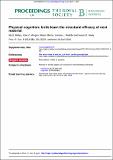Physical cognition : birds learn the structural efficacy of nest material
Abstract
It is generally assumed that birds’ choice of structurally suitable materials for nest building is genetically predetermined. Here, we tested that assumption by investigating whether experience affected male zebra finches’ (Taeniopygia guttata) choice of nest material. After a short period of building with relatively flexible string, birds preferred to build with stiffer string while those that had experienced a stiffer string were indifferent to string type. After building a complete nest with either string type, however, all birds increased their preference for stiff string. The stiffer string appeared to be the more effective building material as birds required fewer pieces of stiffer than flexible string to build a roofed nest. For birds that raised chicks successfully, there was no association between the material they used to build their nest and the type they subsequently preferred. Birds’ material preference reflected neither the preference of their father nor of their siblings but juvenile experience of either string type increased their preference for stiffer string. Our results represent two important advances: (i) birds choose nest material based on the structural properties of the material; (ii) nest material preference is not entirely genetically predetermined as both the type and amount of experience influences birds’ choices.
Citation
Bailey , I E , Morgan , K , Bertin , M , Meddle , S L & Healy , S D 2014 , ' Physical cognition : birds learn the structural efficacy of nest material ' , Proceedings of the Royal Society B: Biological Sciences , vol. 281 , no. 1784 , 20133225 . https://doi.org/10.1098/rspb.2013.3225
Publication
Proceedings of the Royal Society B: Biological Sciences
Status
Peer reviewed
ISSN
0962-8452Type
Journal article
Description
This work was supported by the BBSRC (BB/I019502/1) and Roslin Institute Strategic Grant funding from the BBSRC. The APC was paid through RCUK OA block grant funds.Collections
Items in the St Andrews Research Repository are protected by copyright, with all rights reserved, unless otherwise indicated.

